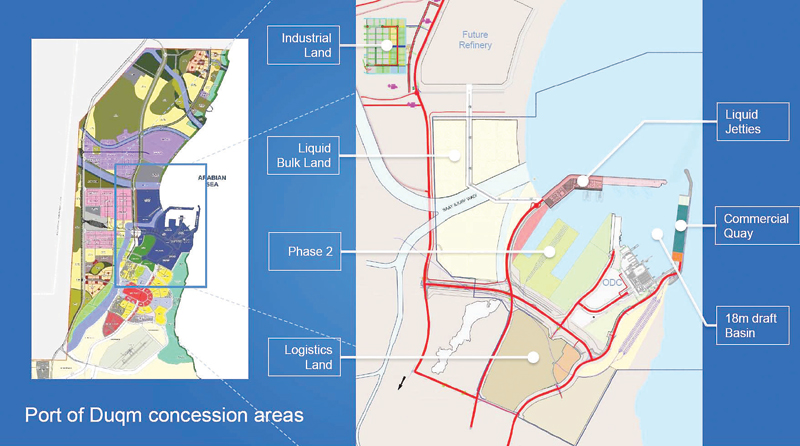

Port of Duqm has announced that it is revisiting the design and master plan of the maritime gateway in response to changing priorities and evolving market dynamics. As part of this exercise, the port is also focused on planning the development of the ‘Second Basin’ — originally envisaged in Phase 2 of its expansion — with an emphasis on new dry bulk capacity, as well as an enhanced role for Duqm as a gateway to Oman’s Oil & Gas producing heartland.
According to CEO Reggy Vermeulen, a revamp of Port of Duqm’s master-plan has been necessitated by changes in the outlook and positioning of the port as a result of shifting market forces.

“Between the time the port was conceived and today, ten years have passed, and the priorities and market dynamics have evolved as well,” said Vermeulen. “We are now (undertaking) a reorganisation and redesign of the entire master-plan of the port. Therefore, we are working on Phase 2 of the port — (centring) on the second basin — with a focus on the extension of Dry Bulk — because it’s the next big resource after Oil & Gas — and will need special infrastructure to be put in place.”
Speaking at the Port Development Middle East Conference, organised by IQPC Events in Muscat earlier this week, the CEO further added: “We are talking about the potential reorganisation of the container part — in terms of what can be captive cargo in the region — and also the increased importance of Duqm Port for the Oil & Gas, both upstream and downstream. These different (objectives) are leading us to a reorganisation of the port, which we are now working on while prioritising the construction of new quay walls, new platforms, the dredging of the second basin, and the acceleration or variation of the existing construction packages meant to be delivered by 2020.”
The Second Basin (representing Phase 2 of the port’s future expansion) is an expansive area located to the west of the quay walls of Oman Dry Dock Company situation within the Port of Duqm.
Phase 1 of the port’s development, Vermeulen said, is currently under implementation with a number of contractors putting in place the infrastructure for terminals designed to handle all manner of cargoes — containerised, dry bulk, project equipment, and liquids.
The port, he further noted, is currently in ‘early operation’ mode. In this mode, it can achieve, for example, 15 container moves per crane per hour with its limited equipment as opposed to a fully functional port that can handle 35 moves per crane per hour.
“So we are capable of receiving any type of cargo, but depending on the type of cargo, (productivity) is slightly slower or with less capacity. Our capacity today is around 300,000 containers per year, but in the area of project cargo we are operating at full capacity and doing around one million tons of heavy pieces per year.”
Besides, the port’s status as an under-construction gateway gives it the flexibility to respond to changes in priorities, market dynamics, or the requirements of the shipping industry both in the Indian Ocean and the hinterland of the port. This hinterland is not limited to the Wusta Governorate, but Saudi Arabia and neighbouring countries, he said.
However, in the short-term spanning the next 4-5 years, Port of Duqm is focused on the supporting the development of the Special Economic Zone (SEZ) in Duqm, said Vermeulen.
“The Duqm Refinery is coming up, and there are big plans for downstream as well as service industries on our liquid terminal. There is a big focus on minerals, such as limestone and dolomite. We need to get ready for this, although the pace of readiness will depend on the market. We are also active on the operational cargo for the Oil & Gas industry, and the import of pipes, hardware and chemicals for the upstream industry as well.”
Oman Observer is now on the WhatsApp channel. Click here



